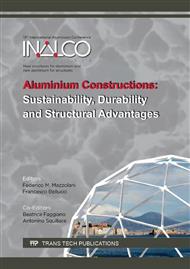p.402
p.409
p.415
p.421
p.427
p.433
p.439
p.445
p.451
(Low-Cycle-) Fatigue Design According to DIN EN 1999-1-3 State of the Art and Current Research
Abstract:
DIN EN 1999-1-3 presents a comprehensive framework for fatigue design of aluminum structures. Various structural details and joints are included. For safety checks against High-Cycle Fatigue, three design concepts are available: Safe-Life-Design, Damage-Tolerant-Design and Design assisted by Testing. Respective safe-life-design lines are based on a databank including results from stress controlled Wöhler fatigue tests. The phenomenon of Low-Cycle-Fatigue (<105 cycles) is treated in Annex F, giving design regulations for selected structural details. Thereby, the influence of different alloys and thus different yield strength values is not considered. In addition, plasticizing effects under high stress ranges are neglected. In general, engineers face the following questions: Which cycle numbers require (Low-Cycle-) fatigue design and thus where is the limit for static design Furthermore, how to define the maximum allowable stress range Respective answers are investigated in a current research project carried out by the Chair of Metal Structures, TU Munich.In this contribution, the state of the art of fatigue design according to DIN EN 1999-1-3 is presented. European design concepts are discussed in view of available data and new developments in research, quality control, fabrication of specimen as well as testing techniques. The focus is then laid on Low-Cycle Fatigue. A new concept, including the influence of alloy type and the effects of plasticizing, is worked on. To this purpose an extensive testing program has started, including a large number of strain-controlled-tests.
Info:
Periodical:
Pages:
439-444
Citation:
Online since:
September 2016
Authors:
Price:
Сopyright:
© 2016 Trans Tech Publications Ltd. All Rights Reserved
Share:
Citation:


